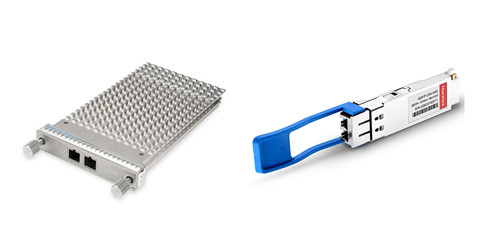The C form-factor pluggable (CFP) is specified by a multi-source agreement (MSA) among many manufacturers for the transmission of high-speed digital signals. The CFP transceiver can both support 100 Gbit/s or OTU4, and 40Gbit/s OTU3 signals. The 40G and 100G CFP transceivers are hot-swappable input/output devices that can be plugged into the 40-Gigabit and 100-Gigabit Ethernet module ports. CFP-40G-LR4 has the same footprint as CFP-100G-LR4, and both of them terminate with duplex SC fiber connectors. Except that they support different transmission distance, what are the detailed information about them?

40G CFP-40G-LR4
The CFP form factor can also operate over 40GbE, supporting both single-mode and multimode fiber and a variety of data rates, protocols, and link lengths, including all the physical media-dependent (PMD) interfaces contained in the IEEE 802.3ba Task Force. 40GBASE CFP optical transceiver module supports 40GBASE Ethernet and OTU3 standards, which can be used in core and distribution layers of data center enterprises, and service provider networks. Cisco releases CFP-40G-LR4, CFP-40G-SR4, and CFP-40G-FR modules.


CFP-40G-LR4, similar with QSFP-40G-LR4, is compatible with IEEE 40GBASE-LR4 standard and operates link length of up to 10km over standard single-mode fiber(OS2). However, CFP-40G-LR4 uses SC duplex connectors with a larger form factor, while QSFP-40G-LR4 utilizes LC duplex connector with a compact footprint ( as shown in the above image).
CFP-100G-LR4
100GBASE CFP modules use 10 x 10 Gbit/s lanes in each direction (RX, TX), the optical connection can support both 10 x 10 Gbit/s and 4 x 25 Gbit/s variants of 100 Gbit/s interconnects (typically referred to 100GBASE-SR10 in 100 m reach respectively and 100GBASE-LR4 in 10 km reach.)
Cisco 100GBASE-LR4 CFP is the 100G CFP type that was designed for long-reach 100GbE applications. CFP-100G-LR4 supports a link length of 10 km on standard SMF with duplex SC connectors. It is running at four optical wavelengths (1295.56 nm, 1300.05 nm, 1304.59 nm, 1309.14 nm) and muxing/demuxing of these wavelengths happening inside CFP module.
Comparison Between CFP-40G-LR4 and CFP-100G-LR4
CFP-40G-LR4 and CFP-100G-LR4 share many points in common, such as the wavelength, fiber type, max distance, fiber optic connector and DOM support. Nevertheless, CFP-40G-LR4 is used in 40GbE network, and CFP-100G-LR4 is in 100GbE.

To further understand the difference between CFP-40G-LR4 and CFP-100G-LR4, let’s have a look at the CFP architecture. According to the below image, the whole CFP diagram is composed of two parts—equipment Line card ASC or FPGA, line card interface and optical line interface. There are several “M-Lines” with 10Gbps speed between equipment line card and electrical interface.

If CFP is working 100GBase-LR4 mode, then it has 10 x 10Gbps M-Lines. As to 40GBase-LR4, it uses 4 x 10Gbps M-Lines. The “gear box” in the image is electrical 10:4 mux/demux module aggregating up to 10 M-Line interfaces in maximum 4 N-Line interfaces. Each N-Line is 25Gbps for 100GBase-LR4 and 10Gbps for 40GBase-LR4. So you may clearly understand the difference between CFP-40G-LR4 and CFP-100G-LR4.
Conclusion
The CFP MSA transceiver module defines hot-pluggable optical transceiver form factors to enable 40GbE and 100GbE applications. CFP-40G-LR4 and CFP-100G-LR4 are the CFP LR4 optics that are compatible with 40GBASE-LR4 and 100GBASE-LR4 standards. Other than the CFP form factor modules, pluggable CFP, CFP2 and CFP4 transceivers support the ultra-high bandwidth requirements of data communications and telecommunication networks that form the backbone of the internet. FS.COM offers a whole sale of CFP/CFP2/CFP4 optical transceivers that available in several standards.
评论
发表评论